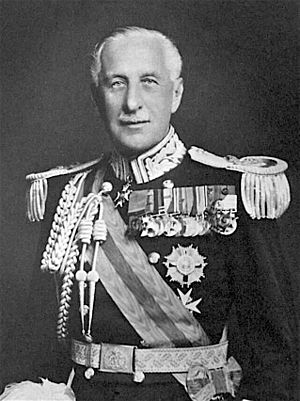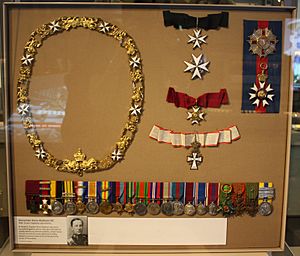Alexander Hore-Ruthven, 1st Earl of Gowrie facts for kids
Quick facts for kids
Brigadier General
The Right Honourable The Earl of Gowrie
|
|
|---|---|
 |
|
| 10th Governor-General of Australia | |
| In office 23 January 1936 – 30 January 1945 |
|
| Monarch | Edward VIII George VI |
| Prime Minister | Joseph Lyons Sir Earle Page Robert Menzies Arthur Fadden John Curtin |
| Preceded by | Sir Isaac Isaacs |
| Succeeded by | The Duke of Gloucester |
| 27th Governor of New South Wales | |
| In office 15 January 1935 – 23 January 1936 |
|
| Monarch | George V Edward VIII |
| Premier | Bertram Stevens |
| Lieutenant | Sir Philip Street |
| Preceded by | Sir Philip Game |
| Succeeded by | Sir David Anderson |
| 20th Governor of South Australia | |
| In office 14 May 1928 – 26 April 1934 |
|
| Monarch | George V |
| Premier | Richard Butler Lionel Hill Robert Richards Richard Butler |
| Preceded by | Sir George Bridges |
| Succeeded by | Sir Winston Joseph Dugan |
| Personal details | |
| Born |
Alexander Gore Arkwright Hore-Ruthven
6 July 1872 Windsor, Berkshire |
| Died | 2 May 1955 (aged 82) Shipton Moyne, Gloucestershire |
| Spouse | Zara Pollok |
| Children | 2, including Patrick |
| Military service | |
| Allegiance | United Kingdom |
| Branch/service | British Army |
| Years of service | 1889–1928 |
| Rank | Brigadier General |
| Battles/wars | Mahdist War |
| Awards | Victoria Cross Companion of the Order of the Bath Distinguished Service Order & Bar Mentioned in Despatches (7) |
Alexander Hore-Ruthven, 1st Earl of Gowrie (born 6 July 1872 – died 2 May 1955) was a brave British Army officer. He later became the 10th Governor-General of Australia, serving from 1936 to 1945. Before this important role, he was the Governor of South Australia (1928–1934) and then Governor of New South Wales (1935–1936).
Gowrie was born in Windsor, Berkshire, England. He joined the army when he was 19. He fought in a conflict in Sudan and was awarded the Victoria Cross for his amazing bravery. This medal is the highest award for courage in the British armed forces. He also served in other campaigns and was an aide to the Lord Lieutenant of Ireland. During the First World War, Gowrie led troops in important battles and received more awards. He finished his military career as a brigadier-general.
In 1928, Gowrie became the Governor of South Australia. He was praised for how he handled difficult political times during the Great Depression. After that, he became Governor of New South Wales. However, this role only lasted a little over a year because he was chosen to be the Governor-General of Australia. During his time as Governor-General, he faced many challenges, including the Second World War. He served for nine years, which is the longest term for any Governor-General of Australia.
Contents
Early Life and Education
Alexander Hore-Ruthven was born on 6 July 1872 in Windsor, Berkshire, England. He was the second son in his family. He went to schools like Eton College and Haileybury and Imperial Service College.
After school, he first worked in a tea office in Glasgow. Then he traveled to British India to work on a tea farm. However, he got sick with malaria and returned to England in 1892.
Military Career and Bravery

On 19 October 1889, Alexander Hore-Ruthven joined the army as a second lieutenant. After returning to England in 1892, he joined the regular army. He became a lieutenant in 1893 and a captain in 1896.
During the Mahdist War in Sudan, he showed incredible courage. On 22 September 1898, during a battle, Captain Hore-Ruthven saw an Egyptian officer who was wounded and in danger. The enemy was very close and firing. Hore-Ruthven bravely picked up the wounded officer and carried him to safety. He even stopped a few times to fire at the enemy to keep them from following. For this heroic act, he was awarded the Victoria Cross.
In 1899, he also received an award from the Sultan of the Ottoman Empire for his service in Sudan. He continued to serve in different parts of the world, including the Somaliland campaign.
In 1905, Hore-Ruthven became an aide to Lord Dudley, who was then the Lord Lieutenant of Ireland. Later, when Lord Dudley became Governor-General of Australia in 1908, Hore-Ruthven went with him as his military secretary. He left Australia in 1910 and went back to military service in India.
World War I Service
When the First World War began, Hore-Ruthven was promoted to major in 1915. He was awarded the Distinguished Service Order (DSO) in 1916 for his leadership. He received another award, a Bar to his DSO, in 1919. This was for his bravery and good judgment in battles in Belgium in 1918. He went to the front lines to encourage his troops, which helped them capture important ground.
He served in France and at Gallipoli, where he was injured. He was mentioned in official reports five times for his actions. He ended the war as a brigadier general. After the war, he commanded British forces in Germany from 1919 to 1920. He continued to hold various important positions in the army. In 1928, he was knighted and appointed Governor of South Australia.
Governor of South Australia
Hore-Ruthven arrived in Adelaide, South Australia, in May 1928. He was very enthusiastic about his new role. He traveled around the state, sometimes even flying in a small plane. He and his wife, Lady Hore-Ruthven, strongly supported youth groups like the Boy Scout and Girl Guide movements. Lady Hore-Ruthven also led the South Australian Red Cross.
During his time as governor, the Great Depression caused many problems in South Australia. The government faced a lot of criticism for its tough economic decisions. Hore-Ruthven supported the Premier, Lionel Hill, during this difficult time. His calm leadership during the crisis was a key reason he was later chosen to be Governor of New South Wales.
Governor of New South Wales
Hore-Ruthven's term as Governor of South Australia ended in April 1934. He returned to England but was soon appointed Governor of New South Wales. At this time, he was also given the title Baron Gowrie. He arrived in Sydney on 21 February 1935. While in England, he had already been asked by King George V about becoming the next Governor-General of Australia. He received another high honor in December 1935.
Governor-General of Australia
Because of his strong military background and experience, Gowrie was a clear choice to become the next Governor-General of Australia in 1936. The Governor-General is the King or Queen's representative in Australia. He took office during the reign of King Edward VIII.

As Governor-General, Gowrie was well-liked in Australia. While the Governor-General no longer had as much direct power as in the past, Gowrie made history in 1938. He visited the Netherlands East Indies (now Indonesia), which was the first time an Australian Governor-General had represented Australia overseas.
In April 1939, the Prime Minister, Joseph Lyons, suddenly passed away. Gowrie had to choose a temporary Prime Minister until the ruling party could pick a new leader. This was one of the few times the Governor-General still had personal choice.
Gowrie's political skills were tested again after the 1940 election. The government lost its majority, meaning the Prime Minister, Robert Menzies, needed the support of independent politicians to stay in power. When Menzies was forced out as leader, the government faced a crisis. Gowrie did not want to call another election so soon, especially with the Second World War happening. He met with the independent politicians and asked them to promise to support the new Labor leader, John Curtin, if he appointed him Prime Minister. They agreed, and Gowrie appointed Curtin. Despite their different backgrounds, Gowrie and Curtin worked well together.
During the Second World War, Gowrie felt it was his duty to support the government and the troops. He visited soldiers and encouraged them. In 1943, he toured Allied Defence Forces in northern Australia and New Guinea. Sadly, shortly before this tour, Gowrie and his wife learned that their son, Patrick, had been killed in Libya.
He officially opened the Australian War Memorial on 11 November 1941.
Gowrie's time as Governor-General ended in September 1944. He returned to Britain and was given new titles: Viscount Ruthven of Canberra and Earl of Gowrie. He also became Deputy Constable of Windsor Castle. He passed away in May 1955 at his home in Gloucestershire.
He was the only Governor-General of Australia to work with five different Prime Ministers during his term.
Family Life
Gowrie married Zara Eileen Pollok on 1 June 1908. She later became Zara Hore-Ruthven, Countess of Gowrie. They had two sons, but one died when he was a baby. Their son, Patrick, was born in 1913 and sadly died in 1942 during the war.
Lady Gowrie was known for her work helping children in Australia. The Lady Gowrie Child Centres were named in her honor. She passed away in 1965.
Lord Gowrie passed away in 1955 at the age of 82. His grandson, Grey, inherited his titles.
Honours and Awards
| Viceregal styles of The Earl of Gowrie |
|
|---|---|
 |
|
| Reference style | His Excellency |
| Spoken style | Your Excellency |

| Victoria Cross (VC) | 1899 | |
| Knight Grand Cross of the Order of St Michael and St George (GCMG) | 1935 | |
| Knight Commander of the Order of St Michael and St George (KCMG) | 1928 | |
| Companion of the Order of St Michael and St George (CMG) | 1918 | |
| Companion of the Order of the Bath (CB) | 1919 | |
| Companion & Bar of the Distinguished Service Order (DSO & Bar) | 1916, 1919 | |
| Knight of Grace of the Venerable Order of St John of Jerusalem | ||
| Queen's Sudan Medal | ||
| Africa General Service Medal with two Clasps | ||
| 1914 Star with Clasp | ||
| British War Medal | ||
| Victory Medal with MID Palm | ||
| 1939–45 Star | ||
| Pacific Star | ||
| Defence Medal | ||
| War Medal 1939–1945 | ||
| Australia Service Medal 1939–45 | ||
| 1911 Delhi Durbar Medal | 1911 | |
| King George V Silver Jubilee Medal | 1935 | |
| King George VI Coronation Medal | 1937 | |
| Queen Elizabeth II Coronation Medal | 1953 | |
| Order of Osmanieh, 4th Class | ||
| Belgian Croix de guerre | ||
| French Croix de guerre 1914–1918 with Bronze star | ||
| Khedive's Sudan Medal with three Clasps | Khalifa | |
| Commander of the Order of the Dannebrog |
See Also
- County of Hore-Ruthven
Images for kids


